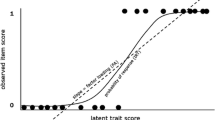Abstract
Uniformly, science teachers express the same goals for their students, goals that emphasize attitude, communication, creativity, and application of knowledge. Yet, the traditional role of the teacher ignores these goals and focuses on attainment of knowledge, rarely going on to applications. This paper suggests, rather specifically, how to provide instruction that leads to the expressed goals. These specific behaviors come from a three-part model where expressed goals define the role of the student and the student's roles are, in turn, stimulated by the teacher.
Similar content being viewed by others
References
Anderson, H. H., and Brewer, J. E. (1946). Studies of classroom personalities, II: Effects of teachers' dominative and integrative contacts on children's classroom behavior.Applied Psychology Monographs No. 8.
Bonnstetter, R. J. (1984). Characteristics of teachers associated with an exemplary program compared with science teachers in general, unpublished doctoral dissertation, University of Iowa, Iowa City, Iowa.
Bronowski, J. (1965).Science and Human Values, Harper and Row, New York.
Dillon, J. T. (1981), Duration of response to teacher questions and statements.Contemporary Educational Psychology 6: 1–11.
Dresman, H. (1982). Classroom climate: Contributions from a European country.Studies in Educational Evaluation, 8: 53–64.
Elkind, D. (1989). Developmentally appropriate practice: Philosophical and practical implications.Phi Delta Kappan, 70: 113–117.
Good, J. E., and Brophy, T. L. (1991).Looking in Classrooms, 5th ed., Harper Collins, New York.
Goodlad, J. (1983).A Place Called School. McGraw-Hill, New York.
Harms, N., and Yager, R. E. (1981).What Research Says to the Science Teacher, Vol. 3, NSTA, Washington, DC.
Krajcik, J. S., and Penick, J. E. (1989). Evaluation of a model science teacher education program.Journal of Research in Science Teaching 26(9): 795–810.
Mullis, I. V., and Jenkins, L. B. (Eds.) (1988).The Science Report Card: Elements of Risk and Recovery, ETS, Princeton, New Jersey.
Myers, L. H. (1988). Analysis of student outcomes in ninth grade physical science taught with a S/T/S focus versus one taught with a textbook orientation, unpublished doctoral dissertation. The University of Iowa, Iowa City, Iowa.
Penick, J. E. (1992). STS instruction enhances student creativity. In Yager, R. E. (Ed.),The Status of Science-Technology-Society Reform Efforts around the World, International Council of Associations for Science Education, Hong Kong.
Project 2000+, (1992). Toward scientific and technological literacy for all: A world conference for 1993, UNESCO, Paris, France.
Raviv, A., Raviv, A., and Reisel, E. (1990) Teachers and students: Two different perspectives? Measuring social climate in the classroom.American Educational Research Journal 27(1): 141–157.
Rogers, C. (1969).Freedom to Learn, Merrill, New York.
Tobias, S. (1990).They're not Dumb, They're Different: Stalking the Second Tier, Research Corporation, Tucson, Arizona.
Withall, J. (1948). The development of a technique for the measurement of social emotional climate in classrooms, unpublished doctoral dissertation, The University of Chicago, Chicago, Illinois.
Withall, J. (1969). Evaluation of classroom climate.Childhood Education 45(7): 403–408.
Withall, J. (1972). Research in systematic observation in the classroom and its relevance to teachers.Journal of Teacher Education 23(3): 330–332.
Yager, R. E., and Penick, J. E. (1983). School science in crisis.Curriculum Review 22(3): 67–70.
Yager, R. E., Tamir, P., and Mackinnu (1991). The effect of an STS approach on achievement and attitudes of students in grades 4–9. Manuscript submitted toAmerican Educational Research Journal.
Author information
Authors and Affiliations
Rights and permissions
About this article
Cite this article
Penick, J.E., Bonnstetter, R.J. Classroom climate and instruction: New goals demand new approaches. J Sci Educ Technol 2, 389–395 (1993). https://doi.org/10.1007/BF00694527
Issue Date:
DOI: https://doi.org/10.1007/BF00694527




